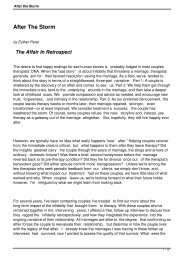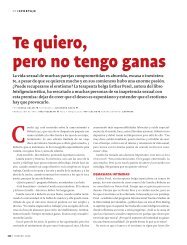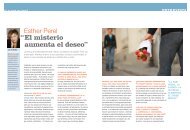The-Double-Flame 2.pdf - Esther Perel
The-Double-Flame 2.pdf - Esther Perel
The-Double-Flame 2.pdf - Esther Perel
You also want an ePaper? Increase the reach of your titles
YUMPU automatically turns print PDFs into web optimized ePapers that Google loves.
<strong>The</strong> <strong>Double</strong> <strong>Flame</strong> 41<br />
Watchers trajectory: you gain the weight back as soon as you are out<br />
of the program.<br />
Many of the internal tensions that crackle in the sexuality of Alicia<br />
and Roberto are located in the reverberations of their childhoods<br />
and in the cultural transmissions they internalized. A multilayered<br />
understanding, the motivation to change, and a good fit between the<br />
partners are necessary to sustain change. But that too is not a guarantee.<br />
I will be meeting with each of them alone to further probe the<br />
nuances of their predicament, but also to map ways to amp up their<br />
erotic pulse. <strong>The</strong> rhythm of the therapy is like a metronome—the needle<br />
points back and forth between the individual and the couple. Each<br />
partner brings memories, apprehensions, expectations, and judgments<br />
to the relationship. <strong>The</strong>y are personal at first, but they always become<br />
relational later.<br />
<strong>The</strong> topics of the individual sessions may be the same; the conversations<br />
will not. For example, the issue of seduction is high on the<br />
list for both Alicia and Roberto. I will explore this with each partner<br />
and will translate for the other afterward. I think that for Alicia, like<br />
many women, seduction is key. It goes way beyond a simple string<br />
of compliments and flattery. Seduction acknowledges that there is no<br />
automatic yes, that sex is not a given, an a priori entitlement to the<br />
other. Seduction recognizes the other as a free agent who can respond<br />
overtly, or suggestively, or choose to ignore it altogether. What matters<br />
is that the receiver is free, not coerced in any way. This need for<br />
autonomy and freedom is essential to desire. For some women it is<br />
difficult to respond when their partner initiates. <strong>The</strong> dance I have seen<br />
goes as follows: He initiates, she pulls back, a while later (5 minutes,<br />
an hour, the next morning) she initiates, and then he welcomes her<br />
and their bodies swiftly interlace. Quite often, though, he responds to<br />
her approach by framing it as a power dynamic. He is hurt, interprets<br />
her advances as a power maneuver where sex can take place only on<br />
her terms, is angry that she will not take him in when he wants to, but<br />
Copyright © 2010 <strong>The</strong> Guilford Press<br />
only when it suits her.<br />
To my mind, this is a misunderstanding of the conflict. For Alicia,<br />
and for many women, accepting his advances blurs the line between<br />
giving and giving in. <strong>The</strong> refusal, the partner’s respect for that refusal,<br />
and then the free return are the tortuous way some women need to<br />
take to experience the autonomy of their desire. It is important to<br />
stress that the manouver is not about power over, but an attempt to<br />
delineate separateness, to ascertain ownership of desire. <strong>The</strong> lyrics of<br />
this song are as follows: “If I respond to you, I feel that I am giving
















